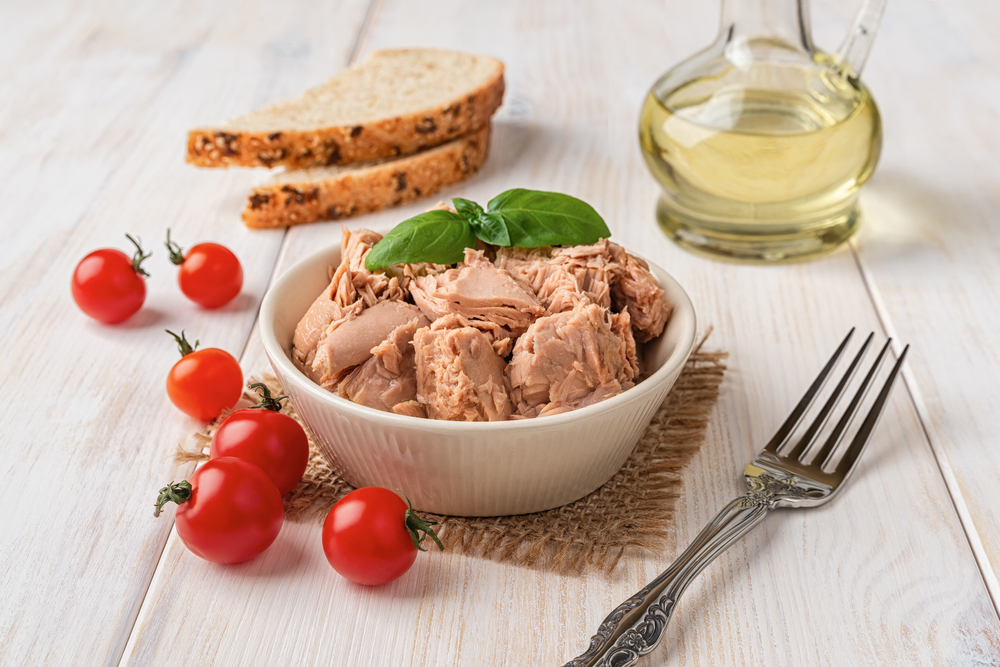If you love eating canned tuna, you should know about these side effects!
Canned tuna is one of my favorite foods in the world because it’s a fabulous choice for quick meals. This fish is packed with omega-3 fatty acids and protein and is popular in kitchens worldwide.
While you might combine it with veggies for a delicious salad, add it on top of your avocado toast, or eat it with rice and roasted vegetables for a filling lunch, it’s not a smart idea to eat it regularly. It tastes good and is amazing for helping you build lean muscles, but it also has a few drawbacks, such as digestive concerns and mercury exposure.
These two issues can impact your brain health and cognitive and motor dysfunction, which can raise questions about how “healthy” this pantry staple really is. So, if you love this canned food as much as I do, you should know about all these side effects. It doesn’t mean you have to cut tuna out entirely—just enjoy it in moderation! So, without further ado, let’s dive into everything you need to know to make your tuna habit a little safer!

1. Sodium overload
As easy as it is to combine this protein-rich food with other delicious ingredients, remember that it’s often packed with sodium, so it can enhance its flavor and keep it fresh for as long as possible.
While salt is incredible for keeping canned fish tasty and fresh, too much of it can raise your blood pressure, which can, therefore, increase the risk of stroke and heart disease. You might think this isn’t such a big deal, but many canned tuna brands contain up to 300-400 mg of sodium per serving, which can add up quickly if you’re not mindful.
If you want to fuel your muscles with all the right things without all this unwanted sodium, choose low-sodium or no-salt-added alternatives. Make sure you always read the nutritional information on the package, so your body receives everything it needs! Another thing you can do is rinse the fish under water before you eat it, so you wash away some of the salt to make it extra good for you.
…Keep reading, because there are many other things you should know!
2. Mercury exposure
As we’ve already expressed, canned tuna usually contains trace amounts of mercury, a natural metal that can become toxic when consumed in large quantities. Mercury enters the ocean as a result of industrial pollution and fish have it in their bodies due to their diets.
If the canned tuna you consume has high mercury levels, it can accumulate in your body, potentially leading to neurological and cognitive issues, particularly in children and pregnant women. As we’ve already mentioned at the beginning of this article, too much mercury could negatively impact your attention, memory, and motor skills over time.
Experts say that light tuna, made from smaller fish species, usually contains less mercury than white tuna, also known as albacore. To make sure you feed your body with all the right nutrients without having too much sodium, it’s best to monitor your weekly intake and limit it to once or twice a week.
…If you’re curious about how mercury in seafood might impact your health, reach out to your doctor to discuss it further! For a safer tuna choice that’s lower in mercury while still packed with healthy fats and lean protein, check out this amazing food!

3. Digestive discomfort
Another side effect people might experience after consuming this type of fish is digestive issues, ranging from mild bloating to more acute stomach discomfort. Have you ever experienced any abdominal pain after eating this food?
Research says that canned foods, in general, are packed with preservatives, potential allergens, and sodium, which can impact your digestive system. They added that canned tuna might also contain histamines, naturally occurring compounds that can often cause allergic reactions or stomach sensitivity in some people.
To avoid digestive issues, experts recommend you choose high-quality brands and rinse your fish before consuming it. This will help you reduce preservatives and help your stomach digest better. If you don’t feel good after eating canned tuna, you can eat frozen or fresh fish to get the same benefits without any discomfort. In case you experience severe cramps, seek medical help ASAP.
4. Kidney health
Sodium is one of the worst side effects of canned tuna, and for good reason. According to doctors, too much of it can put stress on your kidneys, which is even more dangerous for those who suffer from high blood pressure or kidney illness.
When your body receives too much sodium, your kidneys have to work harder to manage it, which can therefore weaken their efficacy at filtering waste. To avoid health issues, it’s best to limit canned foods, rinse them before consumption, and select low-sodium or no-salt-added options.
5. Too much fat
If you love eating canned tuna in oil, you might be consuming too much fat! I know the oil variety tastes better and has a moist texture, but it might contain too much fat for one meal or snack. For example, even if the fish sits in 10 grams of olive oil, which is known for maintaining your heart health and lowering the risk of cardiovascular disease, it might contain too much fat for one meal.
According to the Dietary Guidelines for Americans, roughly 20 to 35% of your daily meals should be fat, which means between 44 and 78 grams on a 2,000-calorie diet. If you do the math, you’ll notice that 10 grams of fat in a can of tuna is too much of your daily recommended value, especially if you plan on eating other healthy fats too, like cheese, avocado, or nuts.

6. Other contaminants and additives
Besides worrying about too much sodium and potential mercury intoxication, other side effects of canned tuna include consuming contaminants like BPA (bisphenol A). This one is a material found in several plastic bottles and cans and is used for protecting the container from breaking.
Even though some people believe the material is harmless, some research suggests that people who consume canned foods regularly have a higher risk of BPA exposure, such as a bigger risk of endocrine diseases. Don’t forget to rinse your canned foods before serving! Take care of your health!
Is canned tuna a good choice?
As you can see, there are many things to keep in mind when you put this type of fish into your cart. There’s no doubt canned tuna is packed with omega-3 fatty acids, selenium, B vitamins, and protein, but it is also rich in things that your body doesn’t need.
If you choose high-quality brands, light tuna in water, and rinse it thoroughly before eating it, you’ll feed your body and muscles with all the right nutrients. Make sure you don’t overconsume it and ask your doctor if it’s safe for you. Other than that, this is still a great option for a healthy and budget-friendly source of protein.
Have you experienced any other side effects from canned tuna? Share your insights in the comments below! We’d love to hear your thoughts, requests, or suggestions for future topics from Nutrition in USA—your feedback helps us bring you the best. Until next time, check out this fantastic post you don’t want to miss: 7 High-Sodium Frozen Foods You Should Not Be Eating!








